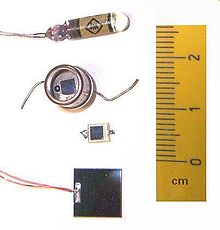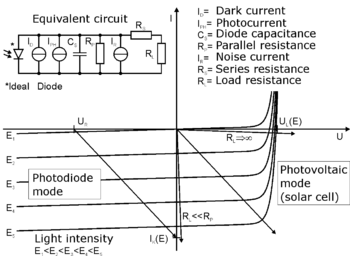- Photodiode
-
A photodiode is a type of photodetector capable of converting light into either current or voltage, depending upon the mode of operation.[1] The common, traditional solar cell used to generate electric solar power is a large area photodiode.
Photodiodes are similar to regular semiconductor diodes except that they may be either exposed (to detect vacuum UV or X-rays) or packaged with a window or optical fiber connection to allow light to reach the sensitive part of the device. Many diodes designed for use specifically as a photodiode use a PIN junction rather than a p-n junction, to increase the speed of response. A photodiode is designed to operate in reverse bias.[2]
Contents
Principle of operation
A photodiode is a p-n junction or PIN structure. When a photon of sufficient energy strikes the diode, it excites an electron, thereby creating a free electron (and a positively charged electron hole). This mechanism is also known as the inner photoelectric effect. If the absorption occurs in the junction's depletion region, or one diffusion length away from it, these carriers are swept from the junction by the built-in field of the depletion region. Thus holes move toward the anode, and electrons toward the cathode, and a photocurrent is produced. This photocurrent is the sum of both the dark current (without light) and the light current, so the dark current must be minimized to enhance the sensitivity of the device.[3]
Photovoltaic mode
When used in zero bias (with the cathode positive) or photovoltaic mode, the flow of photocurrent out of the device is restricted and a voltage builds up. This mode exploits the photovoltaic effect, which is the basis for solar cells – a traditional solar cell is just a large area photodiode.
Photoconductive mode
In this mode the diode is often reverse biased (with the cathode positive), dramatically reducing the response time at the expense of increased noise. This increases the width of the depletion layer, which decreases the junction's capacitance resulting in faster response times. The reverse bias induces only a small amount of current (known as saturation or back current) along its direction while the photocurrent remains virtually the same. For a given spectral distribution, the photocurrent is linearly proportional to the illuminance (and to the irradiance).[4]
Although this mode is faster, the photoconductive mode tends to exhibit more electronic noise.[citation needed] The leakage current of a good PIN diode is so low (<1 nA) that the Johnson–Nyquist noise of the load resistance in a typical circuit often dominates.
Other modes of operation
Avalanche photodiodes have a similar structure to regular photodiodes, but they are operated with much higher reverse bias. This allows each photo-generated carrier to be multiplied by avalanche breakdown, resulting in internal gain within the photodiode, which increases the effective responsivity of the device.
A phototransistor is in essence a bipolar transistor encased in a transparent case so that light can reach the base-collector junction. The electrons that are generated by photons in the base-collector junction are injected into the base, and this photodiode current is amplified by the transistor's current gain β (or hfe). If the emitter is left unconnected, the phototransistor becomes a photodiode. While phototransistors have a higher responsivity for light they are not able to detect low levels of light any better than photodiodes.[citation needed] Phototransistors also have significantly longer response times.
Materials
The material used to make a photodiode is critical to defining its properties, because only photons with sufficient energy to excite electrons across the material's bandgap will produce significant photocurrents.
Materials commonly used to produce photodiodes include[5]:
Material Electromagnetic spectrum
wavelength range (nm)Silicon 190–1100 Germanium 400–1700 Indium gallium arsenide 800–2600 Lead(II) sulfide <1000–3500 Because of their greater bandgap, silicon-based photodiodes generate less noise than germanium-based photodiodes.
Unwanted photodiodes
Any p-n junction, if illuminated, is potentially a photodiode. Semiconductor devices such as transistors and ICs contain p-n junctions, and will not function correctly if they are illuminated by unwanted electromagnetic radiation (light) of wavelength suitable to produce a photocurrent; this is avoided by encapsulating devices in opaque housings. If these housings are not completely opaque to high-energy radiation (ultraviolet, X-rays, gamma rays), transistors and ICs can malfunction due to induced photo-currents. Plastic cases are more vulnerable than metal ones.
Features
Critical performance parameters of a photodiode include:
- Responsivity
- The ratio of generated photocurrent to incident light power, typically expressed in A/W when used in photoconductive mode. The responsivity may also be expressed as a Quantum efficiency, or the ratio of the number of photogenerated carriers to incident photons and thus a unitless quantity.
- Dark current
- The current through the photodiode in the absence of light, when it is operated in photoconductive mode. The dark current includes photocurrent generated by background radiation and the saturation current of the semiconductor junction. Dark current must be accounted for by calibration if a photodiode is used to make an accurate optical power measurement, and it is also a source of noise when a photodiode is used in an optical communication system.
- Noise-equivalent power
- (NEP) The minimum input optical power to generate photocurrent, equal to the rms noise current in a 1 hertz bandwidth. The related characteristic detectivity (D) is the inverse of NEP, 1/NEP; and the specific detectivity (
 ) is the detectivity normalized to the area (A) of the photodetector,
) is the detectivity normalized to the area (A) of the photodetector,  . The NEP is roughly the minimum detectable input power of a photodiode.
. The NEP is roughly the minimum detectable input power of a photodiode.
When a photodiode is used in an optical communication system, these parameters contribute to the sensitivity of the optical receiver, which is the minimum input power required for the receiver to achieve a specified bit error rate.
Applications
P-N photodiodes are used in similar applications to other photodetectors, such as photoconductors, charge-coupled devices, and photomultiplier tubes. They may be used to generate an output which is dependent upon the illumination (analog; for measurement and the like), or to change the state of circuitry (digital; either for control and switching, or digital signal processing).
Photodiodes are used in consumer electronics devices such as compact disc players, smoke detectors, and the receivers for infrared remote control devices used to control equipment from televisions to air conditioners. For many applications either photodiodes or photoconductors may be used. Either type of photosensor may be used for light measurement, as in camera light meters, or to respond to light levels, as in switching on street lighting after dark.
Photosensors of all types may be used to respond to incident light, or to a source of light which is part of the same circuit or system. A photodiode is often combined into a single component with an emitter of light, usually a light-emitting diode (LED), either to detect the presence of a mechanical obstruction to the beam (slotted optical switch), or to couple two digital or analog circuits while maintaining extremely high electrical isolation between them, often for safety (optocoupler).
Photodiodes are often used for accurate measurement of light intensity in science and industry. They generally have a more linear response than photoconductors.
They are also widely used in various medical applications, such as detectors for computed tomography (coupled with scintillators), instruments to analyze samples (immunoassay), and pulse oximeters.
PIN diodes are much faster and more sensitive than p-n junction diodes, and hence are often used for optical communications and in lighting regulation.
P-N photodiodes are not used to measure extremely low light intensities. Instead, if high sensitivity is needed, avalanche photodiodes, intensified charge-coupled devices or photomultiplier tubes are used for applications such as astronomy, spectroscopy, night vision equipment and laser rangefinding.
Comparison with photomultipliers
Advantages compared to photomultipliers:
- Excellent linearity of output current as a function of incident light
- Spectral response from 190 nm to 1100 nm (silicon), longer wavelengths with other semiconductor materials
- Low noise
- Ruggedized to mechanical stress
- Low cost
- Compact and light weight
- Long lifetime
- High quantum efficiency, typically 80%
- No high voltage required
Disadvantages compared to photomultipliers:
- Small area
- No internal gain (except avalanche photodiodes, but their gain is typically 102–103 compared to up to 108 for the photomultiplier)
- Much lower overall sensitivity
- Photon counting only possible with specially designed, usually cooled photodiodes, with special electronic circuits
- Response time for many designs is slower
Photodiode array
A one-dimensional array of hundreds or thousands of photodiodes can be used as a position sensor, for example as part of an angle sensor.[6] One advantage of photodiode arrays (PDAs) is that they allow for high speed parallel read out since the driving electronics may not be built in like a traditional CMOS or CCD sensor.
See also
- Electronics
- Band gap
- Infrared
- Optoelectronics
- Optical interconnect
- Light Peak
- Interconnect bottleneck
- Optical fiber cable
- Optical communication
- Parallel optical interface
- Opto-isolator
- Semiconductor device
- Solar cell
- Avalanche photodiode
- Transducer
- LEDs as Photodiode Light Sensors
- Light meter
- Image sensor
References
 This article incorporates public domain material from the General Services Administration document "Federal Standard 1037C".
This article incorporates public domain material from the General Services Administration document "Federal Standard 1037C".- ^ IUPAC, Compendium of Chemical Terminology, 2nd ed. (the "Gold Book") (1997). Online corrected version: (2006–) "Photodiode".
- ^ James F. Cox (26 June 2001). Fundamentals of linear electronics: integrated and discrete. Cengage Learning. pp. 91–. ISBN 978-0-7668-3018-9. http://books.google.com/books?id=FbezraN9tvEC&pg=PA91. Retrieved 20 August 2011.
- ^ Filip Tavernier, Michiel Steyaert High-Speed Optical Receivers with Integrated Photodiode in Nanoscale CMOS Springer, 2011 ISBN 1441999248, Chapter 3 From Light to Electric Current - The Photodiode
- ^ "Photodiode slide". http://hyperphysics.phy-astr.gsu.edu/hbase/Electronic/photdet.html.
- ^ Held. G, Introduction to Light Emitting Diode Technology and Applications, CRC Press, (Worldwide, 2008). Ch. 5 p. 116. ISBN 1-4200-7662-0
- ^ Wei Gao (2010). Precision Nanometrology: Sensors and Measuring Systems for Nanomanufacturing. Springer. pp. 15–16. ISBN 9781849962537. http://books.google.com/books?id=N0ys_sSxD60C&pg=PA15.
- Gowar, John, Optical Communication Systems, 2 ed., Prentice-Hall, Hempstead UK, 1993 (ISBN 0-13-638727-6)
External links
- Technical Information Hamamatsu Photonics
- Using the Photodiode to convert the PC to a Light Intensity Logger
- Design Fundamentals for Phototransistor Circuits
- Working principles of photodiodes
Electronic components Semiconductors Avalanche diode • Barretter • Darlington transistor • DIAC • Diode • Field-effect transistor (FET) • Insulated-gate bipolar transistor (IGBT) • JFET • Light-emitting diode (LED) • Memristor • MOSFET • Photodetector • PIN diode • Silicon-controlled rectifier (SCR) • Thyristor • Transistor • TRIAC • Unijunction transistor (UJT) • Zener diodeVacuum tubes Vacuum tubes (RF) Backward wave oscillator (BWO) • Cavity magnetron • Crossed-field amplifier • Gyrotron • Inductive output tube (IOT) • Klystron • Maser • Traveling-wave tubeAdjustable Passive Connector (Electrical power, Baseband, RF) • Ferrite • Fuse • Resettable fuse • Resistor (Thermistor) • TransformerReactive Categories:- Optical devices
- Optoelectronics
- Optical diodes
- Photonics
Wikimedia Foundation. 2010.



